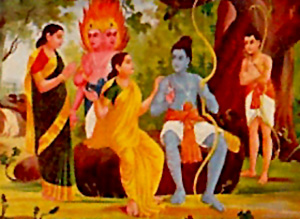 Rama meets Sita in Lanka after the death of Ravana and the coronation Vibhishana to the throne of Lanka. Rama called upon Hanuman and sent him to search for Sita and inform her of all that had befallen. Hanuman found her still by the Ashoka tree, guarded by rakshasis. Hanuman stood before her humbly and told his tale, and she gave him the message that she would like to see her husband Rama. Then the radiant monkey came to Rama and gave him the message of Sita. Rama wept after hearing the message and was plunged in thought, and with a heavy sigh asked Vibhishana to bring Sita to him quickly, bathed and fitly adorned with sandal-paste and jewels.
Rama meets Sita in Lanka after the death of Ravana and the coronation Vibhishana to the throne of Lanka. Rama called upon Hanuman and sent him to search for Sita and inform her of all that had befallen. Hanuman found her still by the Ashoka tree, guarded by rakshasis. Hanuman stood before her humbly and told his tale, and she gave him the message that she would like to see her husband Rama. Then the radiant monkey came to Rama and gave him the message of Sita. Rama wept after hearing the message and was plunged in thought, and with a heavy sigh asked Vibhishana to bring Sita to him quickly, bathed and fitly adorned with sandal-paste and jewels.
Vibhishana hurried towards Sita and gave her the commands of Rama and she obeyed the orders humbly. When she had made herself ready, worthy bearers brought Sita on a palanquin to Rama. Rama, seeing her who had long been the prisoner of Ravana, and overcome with sorrow, was stricken at once with joy, fury and grief. He then requested Vibhishana to bring Sita close to him. Then Vibhishana drove away the crowd of monkeys, bears, and rakshasas, and the attendants with canes and drums roughly hustled the assembled host. But Rama objected to it and ordered that Sita should leave her palanquin and come to him on foot and told Vibhishana that there was no sin when women are seen abroad in time of war or danger, at an own-choice, or at marriage. Sita was not in danger then, and there was no wrong in seeing her. However, he was there to guard her of any danger.
The orders of Rama were obeyed and Sita was humbly brought up to Rama by foot; and she stood shame fast, hiding as it were her true self in her outward shape, beholding the face of Rama with joy, wonder and love. Her sorrow vanished after seeing Rama, and she shone radiant like the moon. But Rama, seeing her stand humbly near him, could no more hold back his speech, and told her that he had killed the demon king Ravana and wiped away the stain upon his honour. The work of Hanuman, in crossing the deep and harrying Lanka and the work of Sugriva with his army and the counsel of Vibhishana contributed a lot in his success, and he was able to fulfill his promise, and accomplishing the duty of a man. Then Sita looked at Rama sadly, like a deer, with tear-filled eyes; and Rama, seeing her so near, but bethinking him of honour in the sight of men, was torn in twain.
Then Rama told that he wiped away the insult to his family and to himself but Sita stained herself by dwelling with another man. Ravana had held her on his lap and gazed on her with lustful eyes. He thus avenged his evil deed, but was unattached to Sita. Then he informs Sita that by a sense of honour he was forced to renounce her, and asked her to choose to stay with either Lakshmana, or Bharata, or Sugriva, or with Vibhishana. Then Sita, hearing that cruel speech of Rama, trembled like a swaying vine, and wept with heavy tears, and she was ashamed before that great assembly. But she wiped the tears from her face, and answered Rama that she was as pure as ever and her heart and soul never deviated from the thought of Rama.
She then told to Rama that if he would not believe in her faithfulness then she had nothing in this world to live. Then she asked Rama why he had not renounced her when Hanuman came to see her in Lanka. She told that she was called the daughter of Janaka but actually she was born of the earth. She then turned towards Lakshmana and requested him to build for her a funeral pyre where she would take refuge. She thus proclaimed that, being branded with an undeserved stigma she would no longer wish to live in this world. Then Lakshmana, with anger and grief, turned to Rama, and in obedience to his gesture he prepared the funeral pyre.












